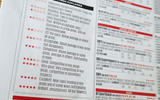Autocar Subscriber Extra is our package of exclusive benefits for our magazine subscribers. One of these is a weekly behind-the-scenes email newsletter from our editors. For a limited time, we're giving all Autocar readers free access to these newsletters and columns. You can subscribe to Autocar magazine with our Summer Sale offer here and save 50% on your first 13 issues.
The Autocar star rating is a topic that inspires pretty frequent correspondence to our offices and inboxes. Peter Juel Thiis Knudsen, an associate professor and forensic pathologist at the University of Southern Denmark (who I hesitate to imagine I may enlighten in any way whatsoever) was the latest reader to write to us and ask why the scores we give on new cars don’t follow what a statistician would call a more ‘normal distribution’. That is, when we rank cars in half-stars out of a maximum score of five, why don’t we give more two-, 2.5- and three-star scores, and instead hand out 3.5-, four- and 4.5-star scores more often than any other?
The answer’s a bit complicated, and it’ll no doubt make me sound like a pedant, for which I apologise in advance - but the truth is that we simply don’t rank new cars in the same way as other titles do. There is a slightly abstract, wide-focus aspect to every Autocar star rating, because we try not to award credit in strictly relative terms.
If we gave the best car in any particular class or niche five out of five, the very worst no stars at all, and slotted everything else in between where it belonged on ‘overall competitiveness’ (eurgh), we would indeed have the normal distribution of scores that Peter expects. But by that philosophy, every class and niche in the car market would have to be treated like a world in its own right. There could be a sizable difference in overall accomplishment and fitness for purpose between a five-star supermini, a five-star executive saloon and a five-star sports car; and you’d have no way to tell from the score which of them might be the best car in the broadest sense. Moreover, a new car could get a 4.5-star recommendation in the week of its introduction but might well be only a three-star prospect by its first birthday, as fresher metal comes in and goes one better.
 We try to make Autocar’s ratings more long-lasting and meaningful than that. Some erosion of any car’s rating is to be expected as it ages, which is why even our scores must be considered in the context of the time at which they were published. But for an explanation of exactly what a five-star car is and does - and the same for 4.5, four, 3.5 and all the way down to no stars at all - look no further than the first page of our New Cars A to Z data section in the back of the magazine every week.
We try to make Autocar’s ratings more long-lasting and meaningful than that. Some erosion of any car’s rating is to be expected as it ages, which is why even our scores must be considered in the context of the time at which they were published. But for an explanation of exactly what a five-star car is and does - and the same for 4.5, four, 3.5 and all the way down to no stars at all - look no further than the first page of our New Cars A to Z data section in the back of the magazine every week.


















Join the debate
Add your comment
I used to be a a Car mad--abolishing, two weekly and one monthly read from cover to cover religiously, now, with the advent of technology, I read what bits I want, costs me nothing, if I need to know more, there are plenty of sites to surf for all things Car, as far as star rating goes, don't we think that's kind of out of date?.